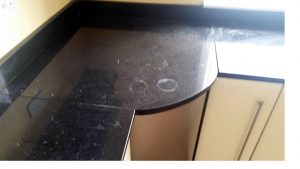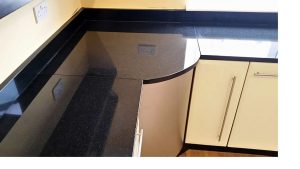Tips for cleaning stone

Natural stone and tile cleaning tips
Spills & Stains
Blot the spill with a paper towel immediately. Don’t wipe the area, it will spread the spill.
Flush the area with plain water and mild detergent and rinse several times. Dry the area thoroughly with a soft cloth. Repeat as necessary. If the stain remains, refer to the section below on stain removal.

Before
Stain Removal
Identifying the type of stain on the stone surface is the key to removing it. If you don’t know what caused the stain, ask yourself .
Where is the stain located? Is it near a plant, if it’s the kitchen its likely to be food or drink? , an area where cosmetics are used? What colour is it? What is the shape or pattern? What goes on in the area around the stain?
Surface stains can often be removed by cleaning with an appropriate cleaning product or household chemical. Deep-seated or stubborn stains may require using a poultice or calling in a professional.

After
The following sections describe the types of stains that you may have to deal with and appropriate household chemicals to use and how to prepare and apply a poultice to remove the stain.
Types of Stains and First Aid Cleaning Actions
- Oil-Based (grease, tar, cooking oil, milk, cosmetics, engine oil, body lotions/creams, waxes, candles)
An oil-based stain will darken the stone and normally must be chemically dissolved so the source of the stain can be flushed or rinsed away. Clean gently with a soft cloth, liquid cleanser with bleach OR household detergent OR ammonia OR white spirit OR acetone. - Organic (coffee, tea, wine, fruit, tobacco, paper, food, urine, leaves, bark, bird droppings)
May cause a pinkish-brown stain and may disappear after the source of the stain has been removed. Outdoors, with the sources removed, normal sun and rain action will generally bleach out the stains. Indoors, clean with a mix hydrogen peroxide (hair bleaching strength) and a few drops of ammonia. - Metal (iron, rust, copper, bronze)
Iron or rust stains are orange to brown in colour and follow the shape of the staining object such as nails, bolts, screws, cans, flower pots and metal furniture. The use of ferrous nitrate in the garden can leave external patios stones stained by yellow blotches. Copper and bronze stains appear as green or muddy-brown and result from the action of moisture on nearby or embedded bronze, copper or brass items. Metal stains must be removed with a poultice. (See section on Making & Using a Poultice.) Deep-seated, rusty stains are extremely difficult to remove and the stone may be permanently stained.
Other rust is a result of natural iron content in the stone that has leached or reacted to excessive moisture over time and oxidised, other metal stains may be due to natural mineral content such as pyrite. - Biological (algae, mildew, lichens, moss, fungi)
Clean with diluted (1/2 cup in a gallon of water) ammonia OR bleach OR hydrogen peroxide. DO NOT MIX BLEACH AND AMMONIA! THIS COMBINATION CREATES A TOXIC AND LETHAL GAS! - Ink (magic marker, pen, ink)
Clean with bleach or hydrogen peroxide (light coloured stone only!) or lacquer thinner or acetone (dark stones only!) - Paint
Small amounts can be removed with lacquer thinner or scraped off carefully with a razorblade. Heavy paint coverage should be removed only with a commercial “heavy liquid” paint stripper available from hardware stores and paint centres. These strippers normally contain caustic soda or lye.
Do not use acids or flame tools to strip paint from stone. Paint strippers can etch the surface of the stone; re-polishing may be necessary. Follow the manufacturer’s directions for use of these products, taking care to flush the area thoroughly with clean water. Protect yourself with rubber gloves and eye protection, and work in a well-ventilated area. Use only wood or plastic scrapers for removing the sludge and curdled paint. Normally, latex and acrylic paints will not cause staining. Oil-based paints, linseed oil, putty, caulks and sealants may cause oily stains. Refer to the section on oil-based stains. - Water spots & rings (surface accumulation of hard water)
Buff with dry 0000 steel wool. - Fire & smoke damage
Older stones and smoke or fire stained fireplaces may require a thorough cleaning to restore their original appearance. Commercially available “carbon removers ” may save time and effort. Use with caution. - Etch marks
Etch marks are caused by acids left on the surface of the stone. Some materials will etch the finish but not leave a stain. Others will both etch and stain. Once the stain has been removed, wet the surface with clean water and sprinkle on marble polishing powder, available from Re-vive, or your local stone dealer. Rub the powder onto the stone with a damp cloth or by using a buffing pad with a low-speed power drill. Continue buffing until the etch mark disappears and the marble surface shines. Contact Re-vive stone restorers for refinishing or re-polishing etched areas that you cannot remove. - Efflorescence
Efflorescence is a white powder that may appear on the surface of the stone. It is caused by water carrying mineral salts from below the surface of the stone rising through the stone and evaporating. When the water evaporates, it leaves the powdery substance. If the installation is new, dust mop or vacuum the powder. You may have to do this several times as the stone dries out. Do not use water to remove the powder; it will only temporarily disappear. If the problem persists, contact Re-vive Stonecare. - Scratches & Nicks
Slight surface scratches may be buffed with dry 0000 steel wool. Deeper scratches and nicks in the surface of the stone should be repaired and re-polished by a professional.
Poultices
Making and Using a Poultice
A poultice is a liquid cleaner or chemical mixed with a white absorbent material to form a paste about the consistency of peanut butter. The poultice is spread over the stained area to a thickness of about 1/4 to 1/2 inch with a wood or plastic spatula, covered with plastic and left to work for 24 to 48 hours. The liquid cleaner or chemical will draw out the stain into the absorbent material. Poultice procedures may have to be repeated to thoroughly remove a stain, but some stains may never be completely removed.
Poultice Materials
Poultice materials include Fuller’s Earth, whiting, diatomaceous earth, powdered chalk, china clay or talc. Approximately one pound of prepared poultice material will cover one square foot. Do not use whiting or iron-type clays such as Fuller’s Earth with acid chemicals. The reaction will cancel the effect of the poultice. A poultice can also be prepared with white paper towels.
Cleaning Agents or Chemicals
Oil based stains:
Poultice with baking soda and water OR one of the powdered poultice materials and mineral spirits.
Organic stains:
Poultice with one of the powdered poultice materials and hydrogen peroxide solution (hair bleaching strength) OR use acetone instead of the hydrogen peroxide.
Iron stains:
Poultice with diatomaceous earth and a commercially available rust remover. Rust stains are particularly difficult to remove. You may need to call a professional.
Copper stains:
Poultice with one of the powdered poultice materials and ammonia. These stains are difficult to remove. You may need to call a professional.
Biological stains:
Poultice with dilute ammonia OR bleach OR hydrogen peroxide. DO NOT MIX AMMONIA AND BLEACH! THIS COMBINATION CREATES A TOXIC AND LETHAL GAS!
Applying the Poultice
- Prepare the poultice. If using powder, mix the cleaning agent or chemical to a thick paste the consistency of peanut butter. If using paper, soak in the chemical and let drain. Don’t let the liquid drip.
- Wet the stained area with distilled water.
- Apply the poultice to the stained area about 1/4 to 1/2 inch thick and extend the poultice beyond the stained area by about one inch. Use a wood or plastic scraper to spread the poultice evenly.
- Cover the poultice with plastic and tape the edges to seal it.
- Allow the poultice to dry thoroughly, usually about 24 to 48 hours. The drying process is what pulls the stain out of the stone and into the poultice material.
- After about 24 hours, remove the plastic and allow the poultice to dry.
- Remove the poultice from the stain. Rinse with water and buff dry with a soft cloth. Use the wood or plastic scraper if necessary.
- Repeat the poultice application if the stain is not removed. It may take several applications for difficult stains.
- If the surface is etched by the chemical, apply polishing powder and buff with a white buffing pad to restore the surface.
Re-vive Stonecare are experts in stone repair and restoration. If you require advice on the installation, repair or restoration of any stone or similar material please get in touch.
Call us to discuss your stone care needs. We offer friendly, no obligation quotations and advice.
Tel. 01787 584413
Mob. 07737 655871




